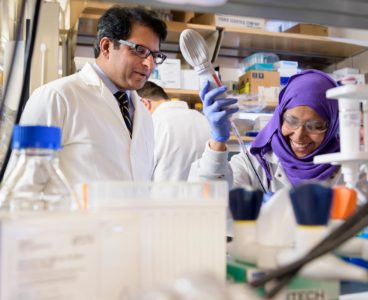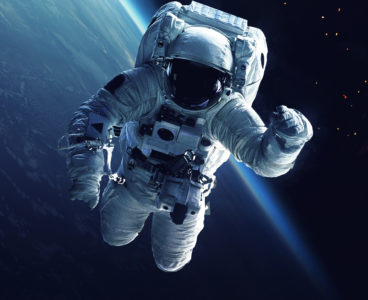The last place most people would expect to find fresh groundwater is tens to hundreds of kilometers offshore in the ocean. Yet not only is that exactly where freshwater can be found, in the ground of the continental shelf beneath the ocean, but simulations have shown that it could be a common occurrence across a…
New Driverless Car Technology Could Make Traffic Lights and Speeding Tickets Obsolete
Imagine a daily commute that’s orderly instead of chaotic. Connected and automated vehicles could provide that relief by adjusting to driving conditions with little to no input from drivers. When the car in front of you speeds up, yours would accelerate, and when the car in front of you screeches to a halt, your car…
Researchers Develop Novel Two-Step CO2 Conversion Technology
A team of researchers at the University of Delaware’s Center for Catalytic Science and Technology (CCST) has discovered a novel two-step process to increase the efficiency of carbon dioxide (CO2) electrolysis, a chemical reaction driven by electrical currents that can aid in the production of valuable chemicals and fuels. The results of the team’s study…
Novel Sensors Make Textiles Smarter
A team of engineers at the University of Delaware is developing next-generation smart textiles by creating flexible carbon nanotube composite coatings on a wide range of fibers, including cotton, nylon and wool. Their discovery is reported in the journal ACS Sensors where they demonstrate the ability to measure an exceptionally wide range of pressure —…
Deep Data Dive Helps Predict Cerebral Palsy
When University of Delaware molecular biologist Adam Marsh was studying the DNA of worms living in Antarctica’s frigid seas to understand how the organisms managed to survive–and thrive–in the extremely harsh polar environment, he never imagined his work might one day have a human connection. But it turns out that the genome of these Antarctic…
Sticky Situation: New Process Turns Wood Scraps Into Tape
Whether you’re wrapping a gift or bandaging a wound, you rely on an adhesive to get the job done. These sticky substances often are made from petroleum-derived materials, but what if there was a more sustainable way to make them? Now, a team of engineers at the University of Delaware has developed a novel process…
Research Reveals New Insights into Hepatitis B
Magic in Metal Could Help Put Excess Carbon Dioxide to Good Use
The chunk of metal sitting on a table in Joel Rosenthal’s office at the University of Delaware looks like it should belong in a wizard’s pocket. Shiny silver with shocks of pink and splashes of gold, it’s called bismuth, and it’s currently used to make products ranging from shotgun pellets to cosmetics and antacids, including…
New Mechanism Essential for Eye Lens Development Identified
If you want to take clear photographs, you don’t use sandpaper to clear a smudge from your camera’s lens. Similarly, if you want to see clearly, the lens of your eye has to be free of obstruction. For that reason a curious thing happens during the development of eye lenses. Instead of closely guarding their…
Ultra-Powerful Batteries Made Safer, More Efficient
From smartphones to electric vehicles, many of today’s technologies run on lithium ion batteries. That means that consumers have to keep their chargers handy. An iPhone X battery only lasts for 21 hours of talk time, and Tesla’s model S has a 335-mile range — which means you could expect to make it from Newark,…
Coastal Water Absorbing More Carbon Dioxide
As more carbon dioxide enters the atmosphere, the global ocean soaks up much of the excess, storing roughly 30 percent of the carbon dioxide emissions coming from human activities. In this sense, the ocean has acted as a buffer to slow down the greenhouse gas accumulation in the atmosphere and, thus, global warming. However, this…
Research Aims to Help Renewable Jet Fuel Take Flight
Airplanes zoom overhead, wispy-white contrails streaming behind them. The Federal Aviation Administration (FAA) handled 43,684 flights, on average, every day last year, and U.S. military and commercial flights together used over 20 billion gallons of jet fuel. All those emissions add up. World air travel contributed 815 million tons of CO2 emissions in 2016 —…
Spacesuits Strengthened by “Liquid Armor”
Astronauts are a smart, courageous and resilient lot, no doubt about that. But when they go out for a walk in space — in environments none of us could survive on our own — they need a lot of protection. There are plenty of perilous possibilities. One of the most serious threats is the stuff…
More Durable, Less Expensive Fuel Cells
A team of engineers at the University of Delaware has developed a technology that could make fuel cells cheaper and more durable, a breakthrough that could speed up the commercialization of fuel cell vehicles. They describe their results in a paper published in Nature Communications on Monday, Sept. 4. Hydrogen-powered fuel cells are a green alternative to…
Acid Zone in Chesapeake Bay Identified
A research team, led by University of Delaware professor Wei-Jun Cai, has identified a zone of water that is increasing in acidity in the Chesapeake Bay. The team analyzed little studied factors that play a role in ocean acidification (OA)–changes in water chemistry that threaten the ability of shellfish such as oysters, clams and scallops…
Engineering on a Blue Streak
A pair of engineers at the University of Delaware has developed a process to form interwoven polymer networks more easily, quickly and sustainably than traditional methods allow. Their secret ingredient? Blue light. Abhishek Shete, graduate research assistant in materials science and engineering, and Christopher Kloxin, assistant professor in materials science and engineering and chemical and…
A New Approach to Improving Lithium-Sulfur Batteries
Rechargeable lithium-ion batteries are the power behind most modern portable electronics, including cell phones, tablets, laptops, fitness trackers, and smart watches. However, their energy density — that is, the amount of energy stored within a given amount of physical space, or mass — will need to be improved for these batteries to see widespread use…
Nightlights Under The Sea
A new study published today in Scientific Reports by University of Delaware researchers and colleagues reveals that 100 feet below the surface of the ocean is a critical depth for ecological activity in the Arctic polar night — a period of near continuous winter darkness. It is at this depth, the researchers said, that atmospheric light diminishes…
Study: Wind Power Fiercer Than Expected
Researchers Take Prints of Storms on the Ocean Floor
Human fingerprints are unique identifiers. The wiggles, curves and ripples cannot be copied or duplicated and provide a distinct signature that represents an individual. In the same way, strong storms — such as Superstorm Sandy — can leave a signature in the form of ripples on the seafloor. Known as ripple bedforms, these small, dynamic…
Highly Tuned Catalytic Controls
You could think of bioorthogonal chemistry as a discreet valet or concierge that steers two world leaders to a private meeting without making noise or trouble along the way. The valet is a catalyst of sorts, arranging the meeting to expedite a result that would not otherwise happen. Bioorthogonal chemistry produces targeted reactions within living…



















